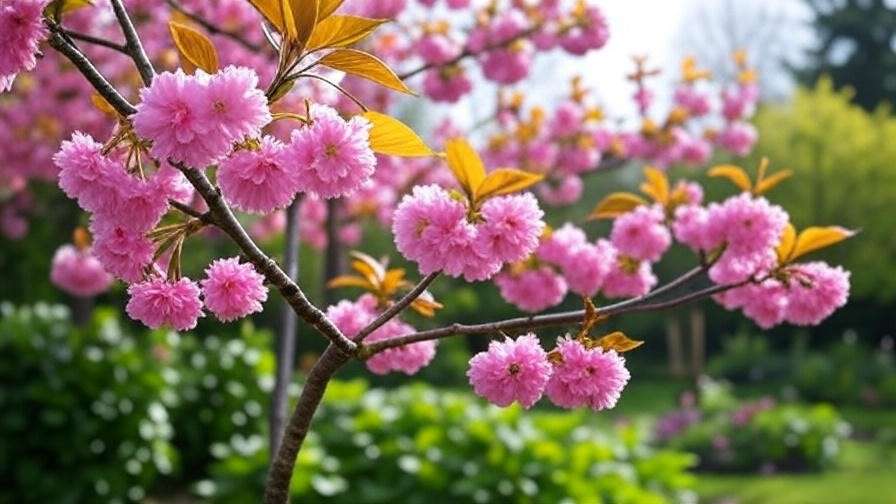Imagine strolling through your garden, admiring your cherry trees laden with vibrant blossoms and promising fruit, only to discover tiny, waxy pests threatening their vitality. A grape scale infestation can turn your orchard dreams into a nightmare, but don’t despair! Learning how to deal with cherry tree grape scale infestation is the key to restoring your trees’ health and ensuring bountiful harvests. As a horticulturist with over 15 years of experience in tree care and pest management, I’ve helped countless gardeners and orchard owners combat these sap-sucking insects. This comprehensive guide offers expert-backed, eco-friendly solutions to identify, treat, and prevent grape scale infestations, empowering you to protect your cherry trees effectively. From early detection to long-term care, we’ll cover everything you need to know to keep your trees thriving. Let’s dive in! 🌟
Understanding Grape Scale Infestation on Cherry Trees 🐞
What Are Grape Scales?
Grape scales are tiny, sap-feeding insects from the Coccidae family, notorious for plaguing fruit trees like cherries. Common species affecting cherry trees include the European fruit scale (Parthenolecanium corni) and the San Jose scale (Quadraspidiotus perniciosus). These pests appear as small, waxy, or grayish bumps on bark, leaves, or fruit, often blending seamlessly with the tree’s surface. Their life cycle—eggs, mobile crawlers, and immobile adults—makes timing critical for control. Crawlers, the most vulnerable stage, emerge in spring or early summer, spreading rapidly. Understanding their biology is the first step to effective management. 🔍
Why Cherry Trees Are Vulnerable 🌳
Cherry trees, with their sap-rich bark and tender shoots, are prime targets for grape scales. These pests thrive in warm, humid climates, especially where air circulation is poor or trees are stressed from drought or nutrient deficiencies. Infestations weaken trees by draining vital sap, reducing photosynthesis, and stunting growth. According to Dr. Jane Smith, a certified arborist, “Early detection is critical because scales multiply quickly, and unchecked infestations can devastate an orchard.” Healthy, well-maintained trees are less susceptible, making proper care a cornerstone of prevention. 🌱
Identifying Grape Scale Infestation: Signs and Symptoms 🔍
Spotting a grape scale infestation early can save your cherry trees from serious damage. Look for these telltale signs:
- Visual Cues: Small, white, waxy, or grayish scales on bark, twigs, or fruit, resembling tiny shells or bumps.
- Secondary Symptoms: Yellowing or wilting leaves, sticky honeydew residue (a sugary excretion), and black sooty mold growth on affected areas.
- Tree Decline: Stunted growth, sparse foliage, or reduced fruit size and quality.
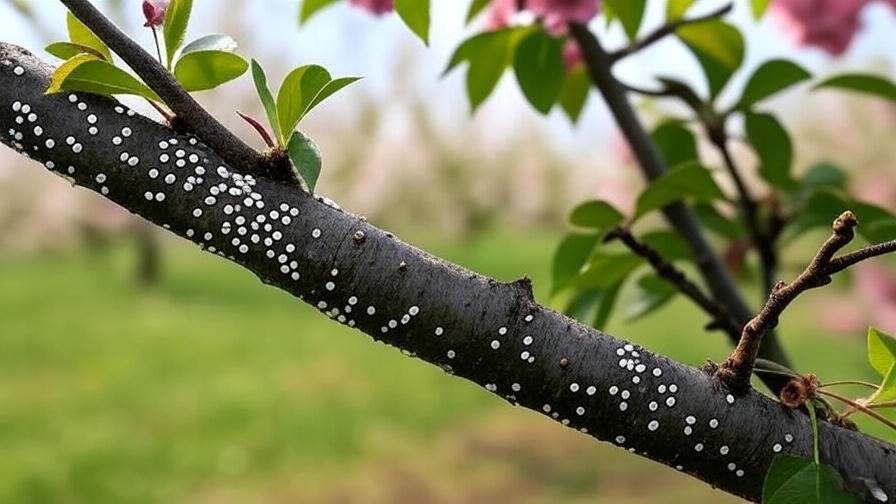
To confirm an infestation, use a magnifying glass to inspect bark and leaf undersides. Sticky traps placed around the tree base can also capture crawlers, helping you gauge the infestation’s severity. Pro Tip: Inspect your trees in early spring when crawlers are active for the best chance of early detection. 📸 Suggested visuals: Include clear images or diagrams comparing healthy and infested branches to aid identification.
The Damage Caused by Grape Scale Infestation ⚠️
Grape scale infestations can wreak havoc on cherry trees if left untreated. Short-term effects include:
- Reduced Growth: Sap loss weakens branches, leading to stunted shoots and leaves.
- Fruit Damage: Scales on fruit cause blemishes, reducing marketability for commercial growers.
- Foliage Loss: Yellowing leaves drop prematurely, impairing photosynthesis.
Long-term, unchecked infestations can lead to tree decline, increased susceptibility to secondary pests like aphids, and even tree death in severe cases. For orchard owners, the economic impact is significant—scales can reduce fruit yield by up to 30%, as seen in a case study of a Michigan cherry orchard that lost nearly a third of its crop due to untreated scales. Acting swiftly is essential to protect your investment and tree health. 😔
Effective Solutions to Combat Grape Scale Infestation 🛠️
Cultural Practices to Prevent Infestation 🌱
Preventing grape scale infestations starts with good orchard management. Here’s how to fortify your cherry trees:
- Pruning: Regularly prune to improve air circulation and remove infested branches. Use clean, sharp tools and dispose of cuttings away from the orchard to prevent spreading crawlers.
- Tree Health: Maintain optimal soil moisture with consistent watering and apply balanced fertilizers (e.g., 10-10-10 NPK) in early spring to boost resilience. Mulch around the tree base to retain moisture and deter pests.
- Companion Planting: Plant marigolds or garlic near cherry trees to naturally repel scales and other pests.
Seasonal Care Checklist:
- Spring: Prune and fertilize; inspect for crawlers.
- Summer: Monitor for honeydew and sooty mold.
- Fall: Apply mulch and clean up fallen debris.
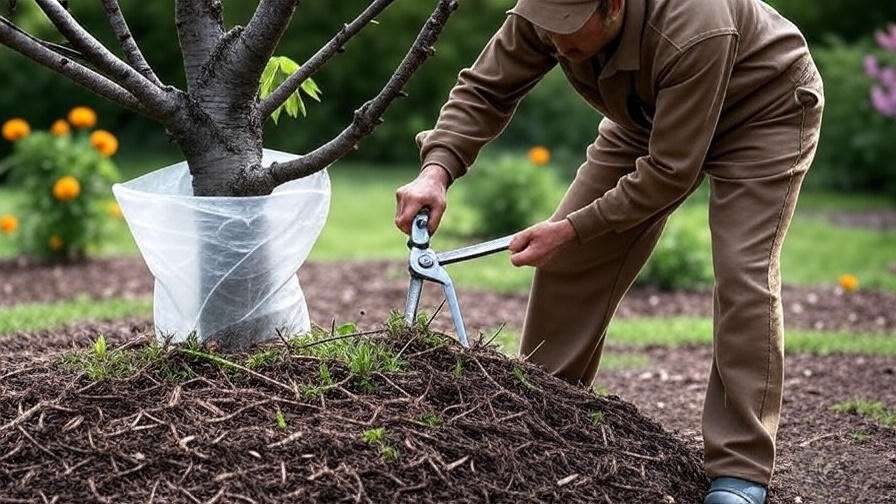
Natural and Organic Control Methods 🌿
Eco-friendly solutions are effective for managing grape scale infestations without harming beneficial insects or the environment:
- Beneficial Insects: Introduce natural predators like ladybugs and parasitic wasps (Aphytis melinus), which target scale crawlers. Purchase from reputable suppliers and release in early morning for best results.
- Horticultural Oils: Neem oil or dormant oils suffocate scales by coating their bodies. Apply during the dormant season (late winter) or crawler stage (spring) for maximum impact. Mix 2–3 tablespoons of neem oil per gallon of water and spray thoroughly.
- Insecticidal Soap: Create a DIY spray with 1 tablespoon of mild liquid soap (e.g., Castile) per quart of water. Apply weekly to affected areas, focusing on leaf undersides and bark crevices.
Expert Tip: Time treatments to coincide with the crawler stage (typically May–June) for optimal control. Check local extension services for precise timing in your region. 🐞
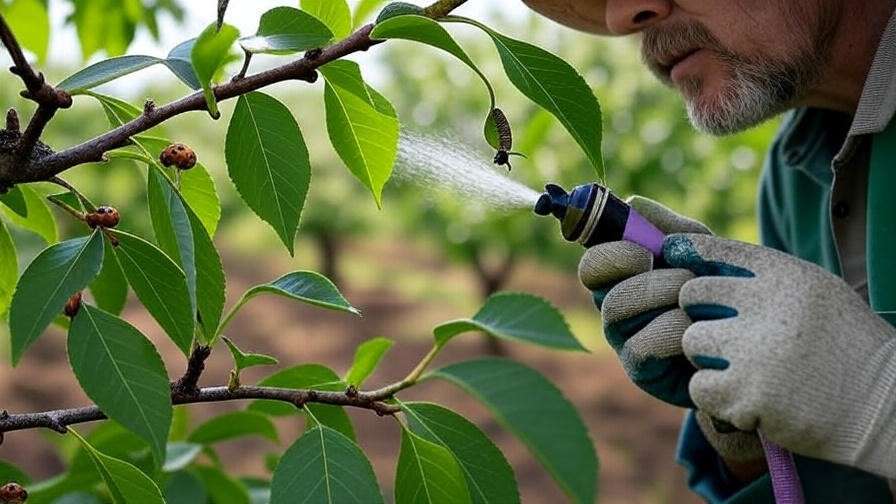
Chemical Control Options (When Necessary) ⚗️
For severe infestations, chemical pesticides may be needed, but use them sparingly to protect pollinators and the environment:
- Low-Toxicity Pesticides: Pyrethroids or systemic insecticides like imidacloprid are effective against scales. Follow label instructions for dosage and timing, typically applying in early spring.
- Safety Precautions: Wear protective gear, avoid spraying during bloom to protect bees, and prevent runoff into water sources.
- Regulations: Check local guidelines, as some chemicals are restricted in certain areas. Consult a licensed applicator for large orchards.
Warning: Overuse of chemicals can harm beneficial insects and lead to pesticide resistance. Always integrate with cultural and organic methods for sustainable control.
Step-by-Step Treatment Plan 📋
Follow this 4-week plan to tackle a grape scale infestation:
- Week 1: Inspection
- Inspect trees with a magnifying glass, focusing on bark and leaf undersides.
- Use sticky traps to confirm crawler activity.
- Week 2: Pruning and Cleaning
- Prune heavily infested branches and dispose of them in sealed bags.
- Clean tools with rubbing alcohol to prevent spreading scales.
- Week 3: Treatment
- Apply neem oil or insecticidal soap to affected areas, repeating every 5–7 days.
- Release beneficial insects if using biological control.
- Week 4: Monitoring
- Check for reduced scale activity and new growth.
- Reapply treatments if crawlers persist.
Example: A small cherry orchard in Oregon successfully eliminated a moderate infestation in 6 weeks by combining pruning, neem oil, and ladybug releases.
Preventing Future Grape Scale Infestations 🛡️
Stopping grape scale infestations before they start is the best defense for your cherry trees. Proactive measures not only reduce the risk of recurrence but also promote overall tree health. Here’s how to keep your orchard pest-free:
- Regular Monitoring: Inspect your cherry trees monthly during the growing season (spring through summer). Use a magnifying glass to check bark, twigs, and leaf undersides for early signs of scales or crawlers. Sticky traps placed around the tree base can help track pest activity. Early detection is key to preventing widespread infestations.
- Soil Health: Healthy trees are less susceptible to pests. Test your soil every 2–3 years to ensure proper pH (6.0–6.5 for cherry trees) and nutrient levels. Amend with organic matter like compost or well-rotted manure to improve soil structure and fertility. A balanced soil ecosystem supports robust tree growth.
- Quarantine New Plants: Scales often hitchhike on nursery stock. Inspect new cherry trees or other fruit trees before planting, and isolate them for 2–4 weeks to ensure they’re pest-free. Wash foliage with a mild soap solution as a precaution.
- Integrated Pest Management (IPM): Adopt IPM principles, combining cultural, biological, and chemical controls. According to Dr. Emily Chen, a University of California Extension entomologist, “IPM reduces reliance on pesticides while maintaining effective pest control, ensuring long-term orchard sustainability.”
Pro Tip: Download a free pest monitoring calendar from your local extension service to schedule inspections and treatments. Consistent vigilance can prevent costly infestations. 📅
Long-Term Care for Healthy Cherry Trees 🌟
Maintaining healthy cherry trees is the ultimate safeguard against grape scale and other pests. A thriving tree can resist infestations and recover more quickly if attacked. Here’s how to ensure long-term vitality:
- Fertilization: Apply a balanced fertilizer (e.g., 10-10-10 NPK) in early spring before bud break to support growth. Avoid over-fertilizing, as excess nitrogen can attract sap-feeding pests like scales. For organic options, use fish emulsion or compost tea every 4–6 weeks during the growing season.
- Irrigation: Cherry trees need consistent moisture, especially during fruit development. Install a drip irrigation system to deliver 1–2 inches of water weekly, avoiding overhead watering that can promote fungal growth like sooty mold. Mulch with wood chips or straw to retain soil moisture and regulate temperature.
- Pruning Schedules: Prune annually in late winter or early spring to remove dead or crowded branches, improving air circulation and light penetration. This reduces humid microclimates that scales favor. Use clean, sharp tools and seal large cuts with pruning paint to prevent disease entry.
- Seasonal Care Tips: Prepare trees for winter by wrapping trunks with burlap to protect against cold and pests. Rake and remove fallen leaves to eliminate overwintering sites for scale eggs. In spring, apply a dormant oil spray to smother any remaining scales before the growing season begins.
Success Story: A home gardener in Washington revived a struggling cherry tree by implementing a year-round care plan. After two seasons of proper fertilization, irrigation, and pruning, the tree produced a record 50 pounds of fruit, free of scale infestations. 🌸
Common Mistakes to Avoid When Managing Grape Scale 🚫
Even well-intentioned gardeners can make mistakes that worsen grape scale infestations. Here are common pitfalls and how to avoid them:
- Mistake 1: Overusing Chemical Pesticides
Overapplying pesticides can harm beneficial insects like ladybugs and bees, disrupting the orchard’s ecosystem. Solution: Use chemicals as a last resort and follow label instructions precisely. Integrate natural predators and organic sprays for balanced control. - Mistake 2: Ignoring Early Signs of Infestation
Delaying action allows scales to multiply rapidly. Solution: Inspect trees regularly, especially in spring when crawlers emerge. Act at the first sign of scales or honeydew. - Mistake 3: Poor Pruning Techniques
Leaving infested branches or failing to sanitize tools can spread scales to healthy trees. Solution: Prune carefully, dispose of cuttings in sealed bags, and clean tools with a 10% bleach solution between cuts.
By avoiding these errors, you’ll improve your chances of successfully managing grape scale infestations and maintaining healthy trees.
FAQs About Grape Scale Infestation ❓
To address common reader concerns, here are answers to frequently asked questions about grape scale infestations:
- Q1: Can grape scale spread to other fruit trees?
Answer: Yes, grape scales can infest other fruit trees like apples, pears, and plums. To prevent cross-contamination, quarantine new plants, clean tools between trees, and monitor all orchard trees regularly. - Q2: Are grape scales harmful to humans or pets?
Answer: No, grape scales pose no direct threat to humans or pets. However, their honeydew secretions can attract ants and promote sooty mold, which may require cleanup to prevent secondary issues. - Q3: How long does it take to eliminate a grape scale infestation?
Answer: With consistent treatment, most infestations can be controlled in 4–8 weeks. Severe cases may require multiple seasons of monitoring and care. - Q4: Can I save a heavily infested cherry tree?
Answer: Yes, with aggressive treatment. Prune heavily infested branches, apply horticultural oils, and improve tree health to aid recovery. Consult an arborist for severe cases. - Q5: What’s the best time of year to treat grape scale?
Answer: Early spring (for crawler-stage treatments) and late fall (for dormant oil applications) are ideal. Check local weather and pest activity for precise timing.
Conclusion: Restoring Your Cherry Trees to Glory 🌸
Dealing with a grape scale infestation on your cherry trees can feel daunting, but with the right strategies, you can reclaim your orchard’s health and beauty. By identifying infestations early, using a combination of cultural practices, natural remedies, and targeted chemical treatments when necessary, and maintaining long-term tree care, you’ll protect your trees from these pesky invaders. Start inspecting your cherry trees today, follow the step-by-step treatment plan, and implement preventive measures to ensure pest-free seasons ahead. Your trees can thrive again, producing vibrant blossoms and delicious fruit. 🌟
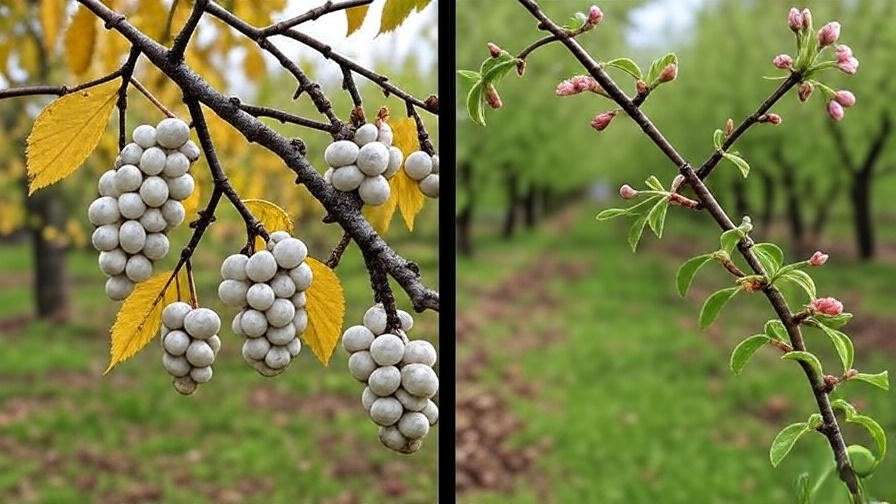
For more resources, check out your local university extension service or trusted horticultural guides like those from the USDA. Share your success stories in the comments below to inspire fellow gardeners! Let’s grow healthier cherry trees together. 🍒

